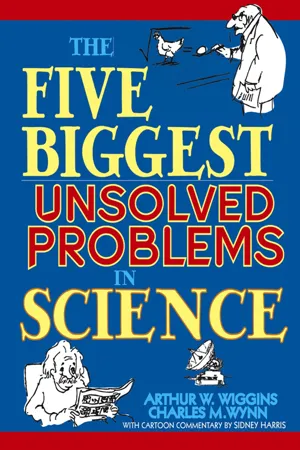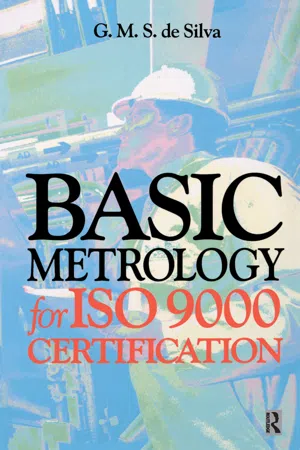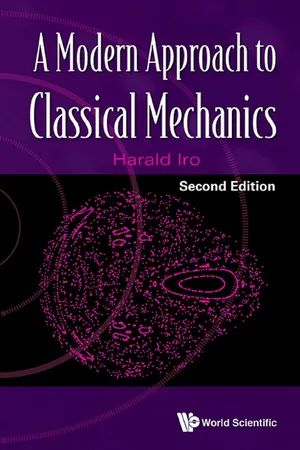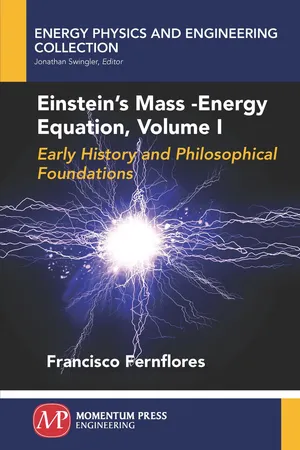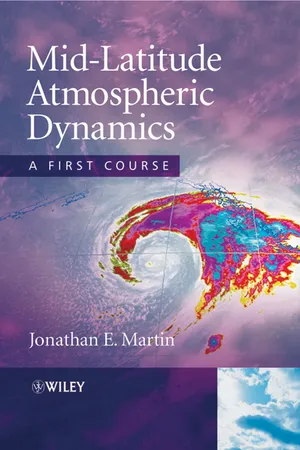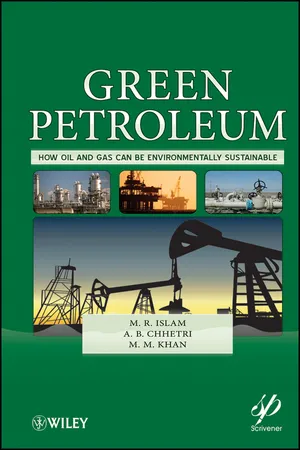Physics
Mass in Physics
Mass in physics refers to the measure of the amount of matter in an object. It is a fundamental property of an object and is typically measured in kilograms. Mass is distinct from weight, which is the force exerted on an object due to gravity. In physics, mass plays a crucial role in determining an object's inertia and its response to external forces.
Written by Perlego with AI-assistance
Related key terms
9 Key excerpts on "Mass in Physics"
- eBook - ePub
From Atoms to Higgs Bosons
Voyages in Quasi-Spacetime
- Chary Rangacharyulu, Christopher J. A. Polachic(Authors)
- 2019(Publication Date)
- Jenny Stanford Publishing(Publisher)
In Newtonian physics, mass is an inherent, invariant property of an object, unlike weight. It is independent of a particle’s other properties or behaviors, including its motion. The concept of mass happens to be the first point of discussion in the Principia, wherein Newton defined this property as a measure of “the quantity of matter…arising from its density and bulk conjunctly.” 3 By 1889, the standard kilogram was defined with reference to a physical cylinder of platinum–iridium alloy, 4 and the carat was thus redefined as a 200 mg mass, no longer requiring any reference to carob beans. Although mass is considered a more fundamental property than weight, it is curiously inaccessible to direct measurement. It is interesting to note how our methods of measuring and assigning mass have evolved over the last two centuries. Until very recently (and only then did exceptions arise in the context of specialized experiments performed on the atomic and subatomic scale), measurements of mass have always been performed indirectly through determination of weight or applied force. We will see, however, that on smaller scales, physicists have approached the problem of mass with an evolving set of techniques to quantify it as a property of a system. In the process, the quasirealist worldview of many physicists has overtaken and redefined this property of matter, which, throughout earlier human history, had a fairly concrete, common-sense basis in everyday life. Newton’s understanding of mass was closely linked with the concept of inertia, which can be understood as the resistance of matter to changes in its state of motion. To measure the mass of a body, in the Newtonian system, is to provide a numerical value to the inertia of the body. Thus, while the mass of a body is not dependent on its state of motion, it is understood as being directly related to the body’s response to such changes when external force is applied - eBook - ePub
- Arthur W. Wiggins, Charles M. Wynn(Authors)
- 2008(Publication Date)
- Trade Paper Press(Publisher)
CHAPTER TWOPHYSICS
Why Do Some Particles Have Mass while Others Have None?
The baby figure of the giant mass Of things to come at large.—William Shakespeare ,Troilus and CressidaPhysics is the study of the properties of matter at rest and in motion and of various forms of energy. Motion-related properties such as velocity, acceleration, and momentum are well understood, as are kinetic and potential energy. What is not understood is the nature of mass, a property of most forms of matter. In fact, the origin of mass is currently the biggest unsolved problem in physics.Mass
We are all too familiar with the fact that mass exists. Mass is self-evident. We all seem to have too much or too little of it. Mass is what makes it harder to push a stalled car than a baby carriage. Mass is what gravity tugs on to keep us grounded on planet Earth.What is not at all clear is the origin of mass. Many, but not all, of the fundamental particles in the universe have mass. Why do some have mass, while others have none? What “gives” mass to some particles and not others? Among particles with mass, why do some have more mass than others? Do particles without mass lack something else besides mass? The answers to these questions may lie in something called the Higgs field, but we’ll need some background information before we can make sense of the elusive Higgs field.To begin with, we know that a body’s mass is related to the amount of matter it contains, and we have a pretty good idea of what forms matter: collections and combinations of atoms. But what forms the atoms? Atoms are composed of electrons, protons, and neutrons. But what forms the electrons, protons, and neutrons? Electrons are fundamental (not composed of “anything else”), but protons and neutrons are not. They are made of quarks, and it is quarks and electrons that appear to be truly fundamental.Before we can discuss the unsolved nature of mass, we’ve got to see where quarks came from. (See Figure 2.1.) In the process, we’ll run across a few other fundamental particles, we’ll see that fields are regarded as even more fundamental than particles, and we’ll investigate physics’ best field theory, called the Standard Model. Next we’ll note the inadequacies of the Standard Model: It doesn’t identify the source of mass, and it omits gravity entirely. Finally, we’ll explore theories beyond the Standard Model that would solve the problem about mass’s origins. - eBook - ePub
Information and the World Stage
From Philosophy to Science, the World of Forms and Communications
- Bernard Dugué(Author)
- 2017(Publication Date)
- Wiley-ISTE(Publisher)
Mass is not reduced to a gravitational force which, incidentally, is not an actual force. We also know inertial mass. However, regardless of the nature of mass, we are dealing with a physics of forces, a type of mechanics and a science of arrangements. Cosmology studies the arrangement of masses in the universe. Rational mechanics studies several types of phenomena, such as how masses clash and transmit to one another a part of energy or impulse. Inertia designates nothing more than the resistance of a mass against any force attempting to move it. Hence, the formula that calculates the acceleration g based on the force F applied to a mass m is F = mg. Rational mechanics also studies another type of movement that differs from translation, namely rotation. Once again, in this case, the inertial mass is opposed to any force aiming to make a solid turn. In physics, mass is a property of matter that describes how material elements are arranged in space and opposed to forces (whichever their origin), and also how they generate forces such as gravitation forces.4.2. Electric charge, spin and dynamics of information
Electric charge remains enigmatic. This charge is a universal constant, and it is discrete rather than continuous. This property has been known since Millikan’s experiment, which makes use of a mechanical property, gravitation, to measure charge. Charged oil droplets are observed under a microscope as they slowly fall in the presence of an electric field. Nonetheless, charge is not essentially a mechanical phenomenon, and this represents a first opening for the physics of information. Mechanical matter is described with mass, but it is another property of matter that brings about electric charge. This charged matter is discrete rather than continuous. Another aspect of this discontinuous matter will be discovered with the quantum mechanics based on the Planck constant, which links the energy of a “photoelectric quantum” to its frequency.Even though “electric physics” describes forces, it cannot be reduced to the mechanics based on masses. As we will see, it also describes processes of communication. However, it is the quantum shift that brought about in striking tones this physics of communication, which takes on a specific meaning if we include the technological applications developed, thanks to scientific discoveries. Thus, “electric physics” has enabled the development of electric motors and plants that can produce electric energy. Mechanics is coupled with the communication born from quantum dynamics. This new property of matter has enabled the invention of multiple technologies that can transmit information and process it digitally. Lasers, hard drives, spin electronics and computers are all the inventions deriving from quantum mechanics. It is a striking, if naturally indirect, proof that we have entered the age of the physics of information. The charge of electrons has been coupled with spin, a property that was inconceivable for classical electron physics and yet essential and fundamental in the context of quantum physics. - eBook - ePub
- G. M. S. de Silva(Author)
- 2012(Publication Date)
- Routledge(Publisher)
4
Mass measurements
4.1 Introduction
Mass measurement is practised widely both in industry and in trade and commerce. Mass is defined as the ‘quantity of matter of an object’. However, the measurement of mass is mostly carried out by weighing, using a variety of balances.4.2 Primary standard and SI units
The SI base unit for mass is the kilogram (kg), defined as the mass of the international prototype kilogram maintained at the Bureau des Poids et Mesure (BIPM) in Sevres, France. The kilogram remains the only artefact standard of the modern SI system of units. The primary standard of mass is also the international prototype kilogram, made from platinum iridium alloy.4.3 Secondary and working standards
At the signing of the Treaty of the Metre, 48 copies of the kilogram were made and distributed to the 48 national laboratories of the member countries. These kilograms constitute the secondary standards of mass. Countries that joined the metre convention later were also given a copy of the kilogram.In addition national laboratories maintain a set of weights known as tertiary standards. These standards are used for the calibration of weights used in industry and trade and commerce, except in those circumstances where uncertainty of the weights requiring calibration demands a higher level standard to be used.4.4 Mass and weight
Mass and weight are often confused as synonymous, though they are two distinctly different quantities. Mass is defined as the amount of matter in an object. It is also defined using Newton's second law of motion, namely:
Force = mass × acceleration(4.1) Each object possesses a property called mass, which appears in the equation as the constant of proportionality between a force (F) applied to the object of mass (m) and the resulting acceleration (a) of the object.The weight - eBook - ePub
- Harald Iro(Author)
- 2015(Publication Date)
- WSPC(Publisher)
2Foundations of classical mechanics
Before establishing the laws, Newton introduces the definitions of mass, force, and quantity of motion. We shall take these as our starting point. Again we also mention Mach’s criticisms of Newton’s formulation, from his book, “The Science of Mechanics” (see Bibliography). Then we present the Newton’s laws in the form used usually in classical mechanics and derive rather general consequences.2.1 Mass, quantity of motion, and force
Newton’s definitions (The Principia, Definitions)Definition I:The quantity of matter is the measure of the same arising from its density and bulk conjointly.… It is this quantity that I mean hereafter everywhere under the name of body or mass. And the same is known by the weight of each body, for it is proportional to the weight, as I have found by experiments on pendulums, very accurately made, which shall be shown hereafter.Definition II:The quantity of motion is the measure of the same, arising from the velocity and quantity of matter conjointly.The motion of the whole is the sum of motions of all parts;…Definition III:The vis insita, or innate force of matter, is a power of resisting, by which every body, as much as in it lies, continues in its present state, whether it be of rest, or of moving uniformly forward in a right line.Definition IV:An impressed force is an action exerted upon a body, in order to change its state, either of rest, or of moving uniformly forward in a right line.Mach criticized Definition I as being a sham, and Definition III as being superfluous in view of Definition IV. Mach was not alone in disliking Newton’s concept of mass: Hertz, too, in his “Principles of Mechanics”, is of the opinion that Newton must have been embarrassed about his enforced definition of mass as a product of volume times density. Newton did not distinguish between the mass appearing in Definition I and the mass referred to in Definition II. The equivalence of this two masses is not evident; we will discuss this later (Section 6.2 ). The modern terms for these masses are gravitational mass and inertial mass - eBook - ePub
- Francisco Fernflores(Author)
- 2017(Publication Date)
- Momentum Press(Publisher)
11.2 MASS: FROM NEWTON TO EINSTEIN
It is sometimes erroneously said that Einstein’s famous equation entails that matter can be converted into energy. Curiously, though perhaps understandably given the history of nuclear energy, seldom is it said that energy can be converted into matter. Yet, the correlation between an object’s energy and its inertial mass in special relativity is clearly symmetric. Furthermore, there is ample evidence that, at least around 1905 and in the following years that led to the development of general relativity in 1916, Einstein did not interpret his result as best expressed by talk of converting matter into energy. One of the main reasons for this is that Einstein focused on how a change to an object’s inertial mass correlates to a change in that object’s “internal” energy, where what is meant by “inertial mass” is not, as Newton would have said, a measure of the “quantity of matter.” We can further appreciate this point by visiting both Newton’s original definition of mass and Mach’s famous criticism of it.1.2.1 NEWTON AND MASSIn Definition 1 of Newton’s Principia , he states, “Quantity of matter is a measure of matter that arises from its density and volume jointly” [2 , p. 403]. In the explanation of the definition, Newton states, “I mean this quantity whenever I use the term ‘body’or ‘mass’in the following pages” [2 , p. 404].2 If we interpret this definition using our contemporary understanding of the mentioned quantities and without attending to the context of the definition, it is clear that Newton is defining the mass m as the product of the density ρ times the volume V - eBook - ePub
- Jeffrey W. Bloom(Author)
- 2010(Publication Date)
- Routledge(Publisher)
Section 4 The Physical SciencesThe National Science Education Standards addressed in this section are: Content Standard B: Physical ScienceK–4: 1 Properties of objects and materials K–4: 2 Position and motion of objects K–4: 3 Light, heat, electricity, and magnetism K5–8: 1 Properties of objects and materials K5–8: 2 Motions and forces K5–8: 3 Transfer of energy Content Standard G: History and Nature of ScienceK–4: 1 Science as a human endeavor K5–8: 1 Science as a human endeavor K5–8: 2 Nature of science K5–8: 3 History of science This section discusses some of the basic concepts involved in our everyday experiences with the physical world. These concepts include mass and weight; forces and motion, energy, work, mechanics, simple machines; the nature and composition of matter, natural resources and their uses; waves, sound, light, and optics; temperature, heat, and thermodynamics; and electrical phenomena.Key Idea 4.1 Mass and Weight
One of the basic concepts in physics and chemistry is “mass.” However, the concept of mass is often confused with the concept of weight. Mass describes the actual substance of matter as it would be when not affected by any kind of force, such as gravity. Weight describes the mass under the influence of gravity . The confusion begins with the measurement of mass and weight, since their units of measurement are the same. Let’s say a particular object has a mass of 20 kg. (1 kilogram = 2.2 pounds). On Earth, that same object weighs 20 kg. However, if this object were taken to the Moon, where the gravity is 1/6th of Earth’s gravity, the object would weigh 3.33 kg, even though the mass has not changed.As the above example demonstrates, weight equals mass times gravity (w = m × g). In everyday usage, we use the American Standard System to express weight in ounces or pounds. Scientists all over the world use the metric system to express mass as grams or kilograms, and Newtons to express the effects of force on mass. - eBook - ePub
Mid-Latitude Atmospheric Dynamics
A First Course
- Jonathan E. Martin(Author)
- 2013(Publication Date)
- Wiley(Publisher)
3Mass, Momentum, and Energy: The Fundamental Quantities of the Physical World
Objectives
Study of the physical world tends to be focused on the quantities known as mass, momentum, and energy. The behavior of the atmosphere is no exception to this rule. In this chapter we will investigate the manner in which these quantities and their various interactions serve to describe the building blocks of a dynamical understanding of the atmosphere at middle latitudes. We must first consider the distribution of mass in the atmosphere and the force balance that underlies this distribution. A number of insights concerning the vertical structure of the atmosphere proceed directly from this understanding.Beginning with Newton’s second law, we will construct expressions for the conservation of momentum in the three Cartesian directions. These expressions are commonly known as the equations of motion and will serve as the fundamental set of physical relationships for all subsequent inquiry in this book. Scale analysis of the horizontal equations of motion will reveal that a simple diagnostic relationship between the mass and momentum fields, geostrophy, characterizes the mid-latitude atmosphere on Earth. Finally, employing these equations of motion we will develop expressions for the conservation of mass and the conservation of energy. We begin by considering the distribution of mass in the atmosphere.3.1 Mass in the Atmosphere
For our purposes, we shall define mass as the measure of the substance of an object and make that measurement in kilograms (kg). Though it was not clear to ancient thinkers like Aristotle,1 the atmosphere has mass. In fact the Earth’s atmosphere has a mass of 5.265 × 1018 - eBook - ePub
Green Petroleum
How Oil and Gas Can Be Environmentally Sustainable
- M. R. Islam, A. B. Chhetri, M. M. Khan(Authors)
- 2012(Publication Date)
- Wiley-Scrivener(Publisher)
2 , then the change in mass is small enough to be neglected. On the other hand, a substantial rate of increase in the momentum of a moving mass on any scale much larger than its acceleration involves a correspondingly substantial increase in mass.The analytical standpoint expressed in Equations 5.2 and 5.3 above work satisfactorily for matter in general, as well as for Newton’s highly specific and peculiar notion of matter in the form of discrete object-masses. Of course, here it is easy to miss the “catch.” The “catch” is the very assumption in the first place that matter is an aggregation of individual object-masses. While this may be true at some empirical level on a terrestrial scale, say, 10 balls of lead shot or a cubic liter of wood sub-divided into exactly 1,000 one-cm by one-cm by one-cm cubes of wood, it turns out, in fact, to be a definition that addresses only some finite number of properties of specific forms of matter that also happen to be tangible and, hence, accessible to us on a terrestrial scale.Once again, generalizing what may only be a special case, before it has been established whether the phenomenon is a unique case, a special but broad case, or a characteristic case, begets all manner of mischief.To appreciate the implications of this point, consider what happens when an attempt is made to apply these principles to object-masses of different orders and/or vastly different scales but within the same reference-frame. Consider the snowflake, a highly typical piece of natural mass. Compared to the mass of an avalanche of which it may come to form a part, the mass of any individual component snowflake is negligible. Negligible as it may seem, however, it is not zero. Furthermore, the accumulation of snowflakes in an avalanche’s mass of snow means that the cumulative mass of snowflakes is heading towards something very substantial, infinitely larger than that of any single snowflake. To grasp what happens for momentum to be conserved between two discrete states, consider the starting-point p = mv.
Index pages curate the most relevant extracts from our library of academic textbooks. They’ve been created using an in-house natural language model (NLM), each adding context and meaning to key research topics.

